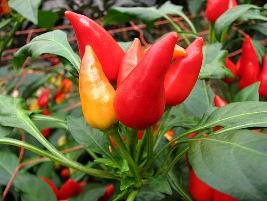The genus Capsicum encompasses a fascinating variety of plants, commonly known as peppers and bell peppers. Species within this genus are classified in various ways, including categories like domesticated, semi-domesticated, and wild. Among the domesticated and widely cultivated species are C. annuum var. annuum, C. baccatum var. pendulum, C. chinense, C. frutescens, and C. pubescens. It’s interesting to note that peppers of the Capsicum genus are not botanically related to other frequently used spices such as black pepper (Piper nigrum), allspice (Pimenta dioica), or pink pepper (Schinus sp.).
Cultivated for various reasons, including food, medicinal, condiment, and ornamental uses, peppers of the Capsicum genus are notable for their versatility. They have a woody or semi-woody stem, are branched, and can grow erect or curved. The leaves are lanceolate, with a bright green color and prominent veins. Plant size can vary, with some dwarf cultivars and others reaching up to 4.9 feet (1.5 meters). Most flowers are white, but there are varieties with purple flowers. The fruits, which are berries, vary in size, shape (spherical, conical, bell-shaped, among others), and color (green, white, yellow, red, orange, black, brown, violet).
The characteristic spicy flavor of peppers is due to the presence of capsaicin and other capsaicinoids. The intensity of spiciness is measured by the Scoville scale, starting with the bell pepper, considered non-spicy (0 units), to the spiciest peppers, like habaneros, which can reach up to 300,000 units on the scale. In cooking, peppers are versatile, used in pickles, sauces, salads, stuffed, among other preparations, and are a key ingredient in various cultures around the world.
Besides these aspects, it’s interesting to highlight the historical and cultural importance of peppers. Native to the Americas, they were one of the first plants to be domesticated in the New World, with evidence of use dating back over 6,000 years ago. After the arrival of Europeans in the Americas, peppers quickly spread around the world, significantly influencing the cuisines of various regions, such as Asia and Europe.
The diversity of peppers is vast, with over 50 known species and thousands of varieties. Each has unique characteristics in terms of flavor, spiciness, size, and color. For example, C. annuum includes both sweet peppers like bell peppers and spicy peppers like jalapeño and cayenne. C. chinense is known for its extremely spicy peppers, like habanero and ghost pepper. Meanwhile, C. baccatum, with its variety pendulum, is famous for peppers like ají amarillo, widely used in South American cuisine.
In the medicinal context, peppers have been studied for their anti-inflammatory, analgesic, thermogenic, and anticancer properties, mainly due to capsaicin. This substance has been used in topical creams to relieve pain and in research for the treatment of conditions like arthritis and cancer.
In landscaping, pepper plants are valued for their vibrant and varied aesthetics. They can be used in herb gardens, vegetable beds, or as ornamental plants in pots. The diversity of colors and shapes of the fruits adds a unique decorative element to the garden. Additionally, they attract pollinators like bees and butterflies, contributing to the biodiversity of the environment. Peppers also have the mystical reputation of warding off the “evil eye” and negative energies in different cultures.
Many people wonder if ornamental pepper cultivars are edible, and although they are cultivated for their aesthetic beauty, it’s important to note that their fruits are edible. However, before consuming these fruits, it is essential to consider a waiting period after acquiring the plant. Unlike peppers specifically grown for consumption, ornamental plant producers may not follow the same strict waiting periods between the application of pesticides and marketing.
This waiting period is crucial to ensure that any residues of pesticides or fungicides have enough time to decompose or decrease to levels safe for human consumption. A wait of at least a few weeks is recommended and, during this period, it’s advisable to perform proper plant maintenance, including adequate watering and, if possible, replacing the substrate with a more natural and organic version, to minimize any potential risk associated with previously used pesticides.
Although pepper plants are perennials, current varieties are generally selected to produce fruits intensely during a short period. After the first year, these plants tend to lose beauty, weaken, produce fewer fruits, and become more susceptible to pests and diseases. To maintain the vitality of pepper plants, it is recommended to renew pots and beds every one or two years, perform flower thinning (reduce the number of flowers), and constantly harvest ripe fruits to promote greater longevity.
For healthy cultivation, pepper plants should be planted in full sun or partial shade, in fertile, deep, light soil enriched with organic matter, and require regular irrigation. They are plants that appreciate frequent fertilizations, weekly during growth and flowering, and bi-weekly during fruiting. It’s important to note that they do not tolerate drought, waterlogging, cold, or frost. Propagation can be done by cutting, but it is more common through seeds, with harvesting generally starting between 100 to 120 days after planting.
In terms of care, it’s crucial to be attentive to the specific needs of each variety. Some, like C. chinense, prefer warmer and more humid climates, while others, like C. annuum, are more tolerant of climate variations. Also, consider the climate of your region. In temperate and subtropical areas, many species can be under full sun, while in tropical to equatorial regions, some shading during the hottest hours of the day may be necessary. Regular pruning helps maintain the shape of the plant and promotes a more abundant fruit production.
The harvest of peppers also varies according to the variety and desired use. Green peppers are generally harvested before full maturation, while peppers for drying or grinding are left on the plant until they reach full maturity. The timing of the harvest can significantly affect the flavor and spiciness of the fruit.

